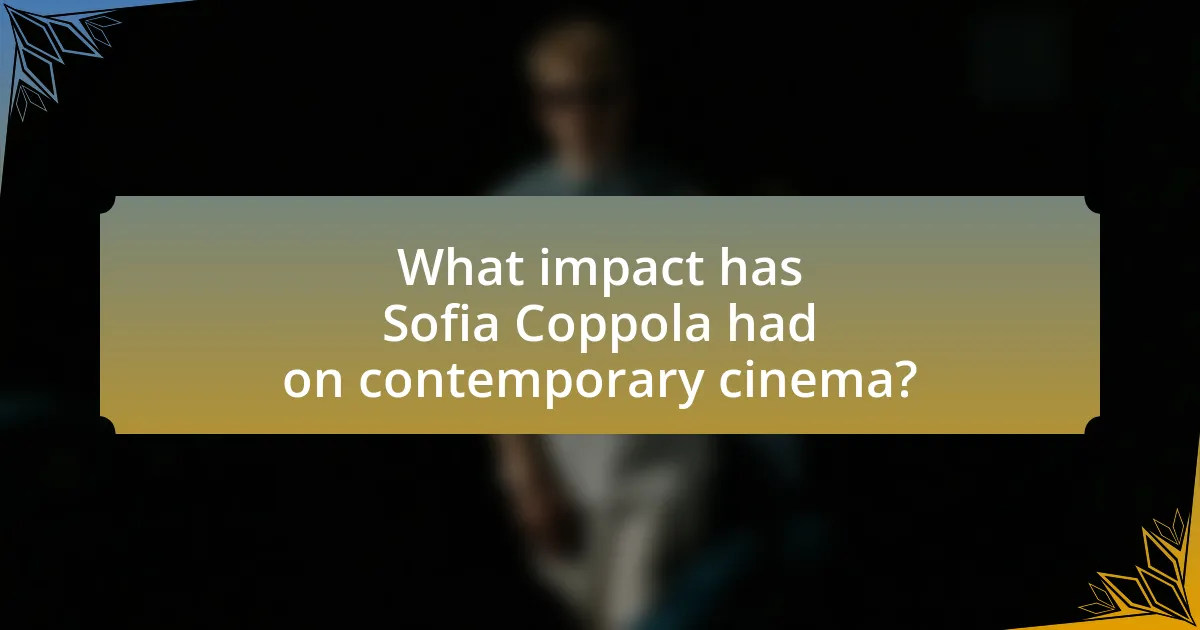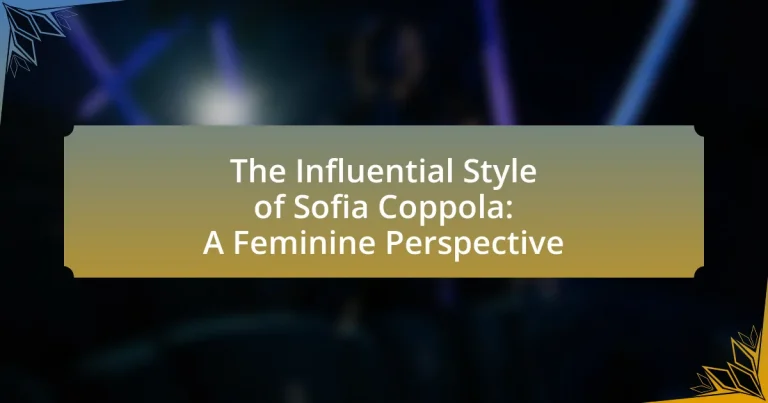Sofia Coppola is a prominent filmmaker known for her distinctive style that emphasizes mood, atmosphere, and the exploration of female perspectives. Her films, such as “Lost in Translation” and “The Virgin Suicides,” are characterized by soft color palettes, meticulous framing, and intimate narratives that delve into themes of isolation, identity, and femininity. Coppola’s background in a filmmaking family informs her unique voice, allowing her to challenge traditional storytelling and gender roles through complex female characters. This article examines the key characteristics of her cinematic style, the impact of her upbringing on her work, and her influence on contemporary cinema and other filmmakers.
What defines Sofia Coppola’s influential style?
Sofia Coppola’s influential style is defined by its emphasis on mood, atmosphere, and the exploration of female perspectives. Her films often feature a distinct visual aesthetic characterized by soft color palettes, meticulous framing, and a focus on intimate, personal narratives. For instance, in “Lost in Translation,” Coppola captures the isolation and emotional depth of her characters through lingering shots and a dreamlike quality, which has become a hallmark of her work. This approach not only highlights the inner lives of women but also challenges traditional storytelling by prioritizing emotional resonance over conventional plot structures.
How does her background influence her filmmaking approach?
Sofia Coppola’s background significantly influences her filmmaking approach by infusing her work with personal experiences and a distinct feminine perspective. Growing up in a filmmaking family, particularly as the daughter of director Francis Ford Coppola, she gained early exposure to the film industry, which shaped her understanding of storytelling and aesthetics. This familial connection allowed her to develop a unique voice that often explores themes of isolation, identity, and the complexities of female experiences, as seen in films like “Lost in Translation” and “The Virgin Suicides.” Her background also includes a blend of cultural influences, having spent time in both the United States and Europe, which enriches her visual style and narrative choices, making them resonate with a broader audience.
What personal experiences shape her narrative choices?
Sofia Coppola’s narrative choices are shaped by her experiences growing up in a filmmaking family, particularly her relationship with her father, Francis Ford Coppola, which instilled a deep understanding of the film industry. This background influences her focus on themes of isolation and femininity, as seen in films like “Lost in Translation” and “The Virgin Suicides.” Additionally, her personal experiences of feeling like an outsider in both her family and society inform her characters’ emotional landscapes, allowing her to explore complex female identities.
How does her upbringing affect her visual storytelling?
Sofia Coppola’s upbringing significantly influences her visual storytelling by shaping her unique perspective and thematic focus. Growing up in a film-oriented family, with her father Francis Ford Coppola as a renowned director, she was exposed to the intricacies of filmmaking from an early age, which cultivated her understanding of visual aesthetics and narrative structure. This background allows her to infuse personal experiences and emotional depth into her films, often exploring themes of isolation and femininity, as seen in works like “Lost in Translation” and “The Virgin Suicides.” Her upbringing not only provides her with technical knowledge but also inspires her to create visually rich narratives that resonate with audiences on a personal level.
What themes are prevalent in her films?
Sofia Coppola’s films frequently explore themes of isolation, identity, and the complexities of female experience. These themes manifest through characters who often find themselves in emotionally detached environments, such as the lonely expatriates in “Lost in Translation” and the disenchanted youth in “The Virgin Suicides.” Coppola’s focus on the inner lives of women highlights their struggles for connection and self-discovery, as seen in her nuanced portrayals of characters navigating societal expectations and personal desires. This thematic consistency is supported by critical analyses that emphasize her unique perspective on femininity and emotional depth in storytelling.
How does Coppola explore femininity in her narratives?
Sofia Coppola explores femininity in her narratives by focusing on the inner lives and emotional complexities of female characters. Her films often depict women in transitional phases, highlighting their struggles with identity, isolation, and societal expectations. For instance, in “Lost in Translation,” the character Charlotte grapples with feelings of disconnection and seeks purpose in a foreign environment, illustrating the search for self amidst external pressures. Additionally, “The Virgin Suicides” presents the Lisbon sisters as enigmatic figures, emphasizing themes of repression and longing, which reflect the constraints placed on women in a patriarchal society. Through these portrayals, Coppola effectively captures the nuances of femininity, showcasing both vulnerability and strength.
What role does isolation play in her storytelling?
Isolation serves as a critical thematic element in Sofia Coppola’s storytelling, often highlighting the emotional and psychological landscapes of her characters. In films like “Lost in Translation” and “The Virgin Suicides,” isolation underscores the characters’ feelings of disconnection and longing, effectively illustrating their internal struggles. This narrative technique allows Coppola to explore complex themes such as loneliness, identity, and the search for connection in a modern, often alienating world. The use of isolation not only enhances character development but also invites the audience to engage with the emotional depth of the story, making it a defining aspect of her cinematic style.
How does her aesthetic contribute to her films’ impact?
Sofia Coppola’s aesthetic significantly enhances her films’ impact by creating a distinct emotional resonance and immersive atmosphere. Her use of soft color palettes, meticulous framing, and a focus on intimate, often solitary moments allows audiences to connect deeply with her characters’ inner lives. For instance, in “Lost in Translation,” the dreamy cinematography and ambient sound design evoke feelings of isolation and longing, which amplify the film’s themes of disconnection and self-discovery. This aesthetic approach not only establishes a unique visual identity but also reinforces the narrative’s emotional depth, making her films memorable and impactful.
What visual techniques does she commonly employ?
Sofia Coppola commonly employs techniques such as soft lighting, pastel color palettes, and meticulous framing in her visual storytelling. These techniques create a dreamlike quality and evoke emotional resonance, often reflecting the inner lives of her characters. For instance, her use of natural light enhances the authenticity of scenes, while the pastel colors contribute to a sense of nostalgia and femininity, as seen in films like “Lost in Translation” and “The Virgin Suicides.”
How does music enhance the emotional depth of her films?
Music enhances the emotional depth of Sofia Coppola’s films by creating an immersive atmosphere that resonates with the characters’ internal struggles. The carefully curated soundtracks often feature melancholic and nostalgic tracks that reflect the themes of isolation and longing prevalent in her narratives. For instance, in “Lost in Translation,” the use of Kevin Shields’ ethereal music underscores the characters’ feelings of disconnection and yearning, effectively deepening the viewer’s emotional engagement. This strategic integration of music not only complements the visual storytelling but also evokes a profound emotional response, making the audience more attuned to the characters’ experiences.
What are the key characteristics of Coppola’s feminine perspective?
Coppola’s feminine perspective is characterized by a focus on the inner lives of women, exploring themes of isolation, identity, and emotional depth. Her films often depict female characters in transitional moments, emphasizing their personal struggles and desires against the backdrop of societal expectations. For instance, in “Lost in Translation,” the protagonist’s sense of alienation in a foreign culture highlights her emotional journey, showcasing Coppola’s ability to capture nuanced female experiences. Additionally, Coppola employs a distinct visual style that often features soft color palettes and intimate framing, further enhancing the emotional resonance of her narratives. This approach not only reflects her unique artistic vision but also contributes to a broader understanding of women’s perspectives in cinema.
How does she portray female characters in her films?
Sofia Coppola portrays female characters in her films as complex individuals navigating their identities and desires within constrained environments. Her films often highlight themes of isolation and introspection, showcasing women who grapple with societal expectations and personal aspirations. For instance, in “Lost in Translation,” the character Charlotte experiences profound loneliness despite being in a vibrant city, reflecting a nuanced exploration of emotional depth. Additionally, in “The Virgin Suicides,” Coppola presents the Lisbon sisters as enigmatic figures, emphasizing their struggles against the confines of their suburban life. This portrayal is supported by critical acclaim, as her work has been recognized for its authentic representation of female experiences, earning Coppola an Academy Award for Best Original Screenplay for “Lost in Translation.”
What complexities do her female protagonists exhibit?
Sofia Coppola’s female protagonists exhibit complexities such as emotional depth, existential struggles, and a nuanced understanding of identity. These characters often grapple with feelings of isolation and disconnection, as seen in films like “Lost in Translation,” where the protagonist experiences profound loneliness despite being in a vibrant city. Additionally, they navigate societal expectations and personal desires, reflecting a tension between traditional roles and modern aspirations, which is evident in “The Virgin Suicides,” where the sisters confront the constraints of their environment. This portrayal of multifaceted emotional landscapes allows audiences to engage with the characters on a deeper level, highlighting their struggles and resilience in a patriarchal society.
How does she challenge traditional gender roles through her characters?
Sofia Coppola challenges traditional gender roles through her characters by depicting women who defy societal expectations and assert their independence. In films like “Lost in Translation” and “The Virgin Suicides,” her female protagonists navigate complex emotional landscapes, often rejecting conventional paths of marriage and motherhood. For instance, in “The Virgin Suicides,” the Lisbon sisters embody a rebellion against the restrictive norms imposed by their suburban environment, ultimately seeking autonomy in their tragic choices. This portrayal highlights the internal struggles women face against societal pressures, thereby subverting traditional narratives that often confine female characters to passive roles.
In what ways does her perspective differ from male filmmakers?
Sofia Coppola’s perspective differs from male filmmakers primarily in her focus on intimate, emotional narratives that explore the inner lives of female characters. Unlike many male filmmakers who often emphasize action or external conflict, Coppola’s films, such as “Lost in Translation” and “The Virgin Suicides,” delve into themes of isolation, longing, and the complexities of womanhood. This approach is supported by her use of visual storytelling techniques that prioritize mood and atmosphere over traditional plot structures, allowing for a more nuanced exploration of female experiences. Additionally, Coppola’s emphasis on aesthetics and the subtleties of everyday life contrasts with the more conventional, often male-centric narratives prevalent in mainstream cinema.
What unique storytelling methods does she utilize?
Sofia Coppola utilizes a unique storytelling method characterized by a focus on atmospheric visuals and introspective character development. Her films often emphasize mood and emotion over traditional plot structures, allowing viewers to engage deeply with the internal experiences of her characters. For instance, in “Lost in Translation,” Coppola employs long takes and minimal dialogue to convey the isolation and longing of the protagonists, effectively immersing the audience in their emotional landscape. This approach is supported by her use of carefully curated soundtracks that enhance the emotional resonance of scenes, further establishing a distinct narrative style that prioritizes feeling over conventional storytelling.
How does her perspective influence audience reception?
Sofia Coppola’s perspective significantly influences audience reception by presenting nuanced female experiences that resonate emotionally with viewers. Her films often explore themes of isolation, identity, and the complexities of womanhood, which invite audiences to engage deeply with the characters’ inner lives. For instance, in “Lost in Translation,” Coppola’s portrayal of loneliness in a foreign environment allows viewers to empathize with the characters’ emotional struggles, enhancing their connection to the narrative. This unique lens not only challenges traditional storytelling but also fosters a more inclusive understanding of diverse female experiences, ultimately shaping how audiences interpret and relate to her work.

What impact has Sofia Coppola had on contemporary cinema?
Sofia Coppola has significantly impacted contemporary cinema by introducing a distinctively feminine perspective that emphasizes emotional depth and character introspection. Her films, such as “Lost in Translation” and “The Virgin Suicides,” showcase a unique narrative style that often explores themes of isolation, identity, and the complexities of modern relationships. Coppola’s work has been recognized for its visual aesthetics and atmospheric storytelling, earning her an Academy Award for Best Original Screenplay for “Lost in Translation.” This recognition highlights her influence in shaping narratives that resonate with both female and male audiences, ultimately contributing to a broader acceptance of diverse storytelling in the film industry.
How has her work influenced other filmmakers?
Sofia Coppola’s work has significantly influenced other filmmakers by introducing a distinctively introspective and atmospheric storytelling style that emphasizes emotional depth and character-driven narratives. Her films, such as “Lost in Translation” and “The Virgin Suicides,” showcase a unique blend of visual aesthetics and subtle performances, inspiring a generation of filmmakers to explore themes of alienation and femininity in their own works. This influence is evident in the works of directors like Greta Gerwig and Andrea Arnold, who have cited Coppola’s approach to storytelling and visual composition as pivotal in shaping their artistic visions.
What stylistic elements have been adopted by her peers?
Her peers have adopted stylistic elements such as minimalism, a focus on character-driven narratives, and an emphasis on atmospheric visuals. These elements reflect Sofia Coppola’s influence, particularly her use of sparse dialogue and rich imagery to convey emotion and mood. For instance, films like “Lost in Translation” and “The Virgin Suicides” showcase how her contemporaries incorporate similar techniques to create introspective and visually striking storytelling.
How does her approach inspire new narratives in film?
Sofia Coppola’s approach inspires new narratives in film by emphasizing the inner lives and emotional complexities of female characters. Her films, such as “Lost in Translation” and “The Virgin Suicides,” showcase a unique perspective that challenges traditional storytelling by focusing on themes of isolation, identity, and the subtleties of human connection. This focus on nuanced character development allows for a broader representation of women’s experiences in cinema, encouraging filmmakers to explore diverse narratives that reflect contemporary societal issues. Coppola’s distinctive visual style and use of silence further enhance these narratives, creating a space for introspection and emotional resonance that is often overlooked in mainstream film.
What recognition has she received for her contributions?
Sofia Coppola has received numerous accolades for her contributions to film, including an Academy Award for Best Original Screenplay for “Lost in Translation” in 2004. This recognition highlights her unique storytelling ability and her impact on the cinematic landscape, particularly in portraying feminine perspectives. Additionally, she has been honored with the Best Director award at the Cannes Film Festival for “The Virgin Suicides” in 1999, further establishing her as a significant figure in contemporary cinema.
What awards highlight her achievements in filmmaking?
Sofia Coppola has received several prestigious awards that highlight her achievements in filmmaking, including the Academy Award for Best Original Screenplay for “Lost in Translation” in 2004. This recognition marked her as the third woman ever to be nominated for this category, underscoring her significant impact on the film industry. Additionally, she won the Golden Globe Award for Best Motion Picture – Musical or Comedy for the same film, further solidifying her status as a leading filmmaker. Her work has also been recognized at the Cannes Film Festival, where she won the Best Director award for “The Beguiled” in 2017, making her the second woman to achieve this honor in the festival’s history. These awards collectively reflect her unique voice and contributions to cinema.
How do critics view her influence on the film industry?
Critics view Sofia Coppola’s influence on the film industry as significant and transformative, particularly in her portrayal of female perspectives and emotional depth. Her films, such as “Lost in Translation” and “The Virgin Suicides,” are often cited for their unique storytelling style that emphasizes introspection and atmosphere over traditional narrative structures. Critics highlight her ability to create visually stunning and emotionally resonant works that challenge conventional gender roles in cinema, thereby paving the way for more diverse female voices in filmmaking. This recognition is supported by numerous accolades, including an Academy Award for Best Original Screenplay, which underscores her impact on both audiences and the industry at large.
What can aspiring filmmakers learn from Sofia Coppola’s style?
Aspiring filmmakers can learn the importance of atmosphere and emotional depth from Sofia Coppola’s style. Her films often emphasize mood through meticulous attention to visual aesthetics, such as color palettes and lighting, which create immersive experiences. For instance, in “Lost in Translation,” the use of Tokyo’s neon lights and intimate settings enhances the themes of isolation and connection. Additionally, Coppola’s focus on character-driven narratives allows for nuanced storytelling, as seen in “The Virgin Suicides,” where the inner lives of characters are explored in a way that resonates with audiences. This approach underscores the significance of character development and emotional authenticity in filmmaking.
How can they incorporate her techniques into their own work?
To incorporate Sofia Coppola’s techniques into their own work, filmmakers can focus on her use of atmospheric storytelling, character-driven narratives, and visual aesthetics. By emphasizing mood and emotion over plot, they can create immersive experiences similar to Coppola’s films, such as “Lost in Translation,” which showcases the power of silence and subtlety in storytelling. Additionally, adopting her distinctive visual style, characterized by soft color palettes and meticulous framing, can enhance the overall impact of their projects. This approach is validated by Coppola’s consistent ability to evoke deep emotional responses through her unique cinematic language, as seen in her award-winning films.
What best practices can be derived from her storytelling approach?
Sofia Coppola’s storytelling approach emphasizes authenticity, emotional resonance, and visual aesthetics as best practices. Authenticity is achieved through personal narratives that reflect genuine experiences, allowing audiences to connect deeply with characters. Emotional resonance is cultivated by focusing on the inner lives of characters, often highlighting themes of isolation and longing, which enhances viewer empathy. Visual aesthetics are prioritized through meticulous attention to cinematography and production design, creating immersive environments that complement the narrative. These practices are evident in films like “Lost in Translation,” where the combination of personal storytelling and striking visuals effectively engages the audience.


